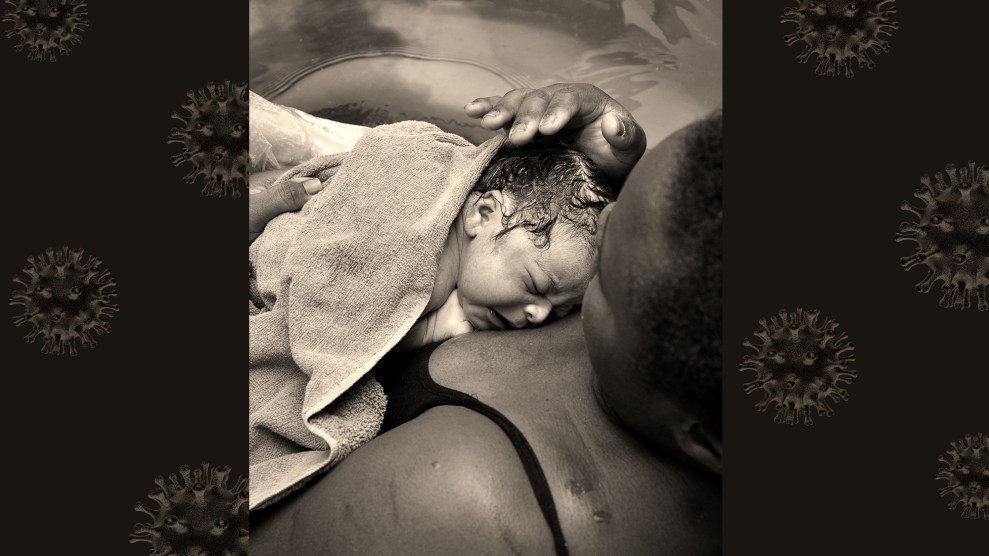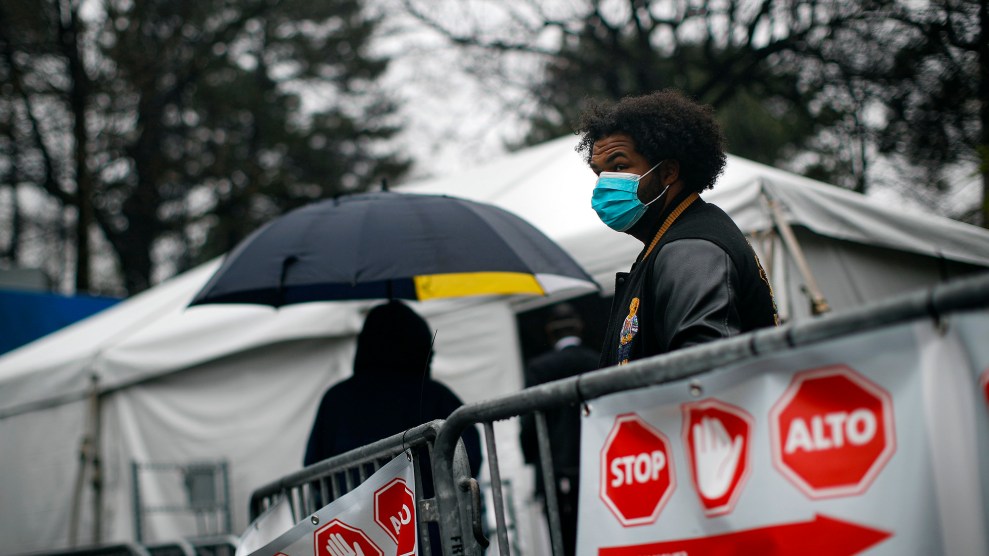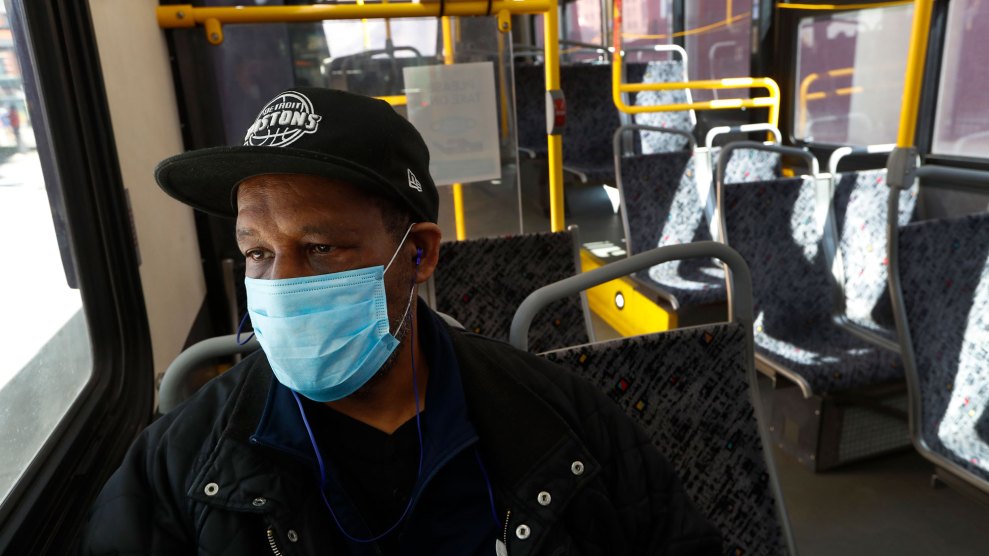
Mother Jones illustration; Getty
As a low-income, Black mother of seven, Laurie Bertram Roberts has limited faith in the medical establishment. So do her children. Back in March, when her middle daughter Kayla’s due date was inching closer amid a global pandemic, they made a decision: Kayla would deliver her baby at home.
It wasn’t just one thing that made their decision. It was that the coronavirus disproportionately affects communities of color and was creeping up in Mississippi, where they live. It was that Kayla has asthma, and they worried that would make her more vulnerable to the coronavirus. It was that Roberts, a prominent reproductive rights advocate who runs a local abortion fund, had been training as a midwife, and she had everything they needed for a home birth. It was that, at Kayla’s doctor’s appointment, she was told she had low fluid, which Roberts interpreted as a sign that the doctor may want to induce labor, and they worried that a hasty decision would result in a cesarean. “It’s actually one of fastest ways that especially low-income Black women get sent in for C-sections,” Roberts explains, and Kayla wanted to avoid that.
“I was talking to one of my midwife friends, and I said, ‘Girl, I think I might have to catch this baby, and I don’t really know if I want to catch my grandbaby,'” Roberts tells me recently.
They found a midwife, Sabrina Ferrage—who came recommended by a trusted friend, had reasonable rates, and, importantly, had experience serving low-income and rural women. (Ferrage, who is also a doula, is a lay midwife, which means she has informal training.)
Kayla was not alone in her decision to recently give birth at home. In the past several months, since the coronavirus upended life globally, pregnant people have been increasingly turning to home birth as an option to avoid hospitals. Midwives and doulas have been reporting higher demand for their services—and, anecdotally, all the care providers and medical associations interviewed for this story said they’ve noticed a higher volume of requests for home birth or questions about whether it’s a safer option given the pandemic. The American Academy of Pediatrics (AAP) responded by releasing some new guidelines for home births in April that included an updated checklist for caring for the newborn.
This uptick has been portrayed as something of a growing trend in home births among “crunchy” white women who are looking for a more “natural” experience. And the AAP recently confirmed that home births are increasing largely among non-Hispanic white women. This narrative, though, essentially ignores the pregnant people like Kayla, the low-income women of color for whom home birth is now often framed as a luxury. And while, to be clear, there’s no research to suggest home birth is safer for them and the American College of Obstetricians and Gynecologists (ACOG) warns that home birth carries significant risks, there is a segment of Black people—midwives, reproductive rights activists, civilians—who are committed to offering home births as a safe option for their peers, particularly now, during crises that have laid bare the stark inequities in the medical system and the stress that comes with being Black in this country. Black women, after all, are three times more likely to die in childbirth in the United States than white women, even with hospital care.
“The solutions are within our communities, and people need to trust Black women, listen to Black women, and invest in Black women,” says Angela Doyinsola Aina, the interim executive director at Black Mamas Matter Alliance, an Atlanta-based reproductive justice advocacy group. Aina works to educate Black pregnant people about reproductive issues and care alongside a crucial but often-forgotten history, pointing out the rich tradition of Black midwifery; enslaved West African women were considered spiritual healers and leaders in their communities, and they brought their knowledge of midwifery to the US, in turn fostering a rich tradition of African American midwifery.
“Home birthing, midwifery practice, just pregnancy and childbirth in and of itself is something that is traditional and derived from Black and African women’s cultures,” she says. “One of the primary reasons why there was an increase of capturing enslaved female Africans was for the sole purpose of being able to practice midwifery, and of course use our Black women’s bodies as vessels to quote-unquote produce more slaves.”
But, Aina says, with the rise of the Industrial Revolution and the professionalization of medicine, midwifery—and Black midwives in particular—began to be regulated out of the birth work space, which has in turn made home birth options less accessible to Black pregnant people. Roberts tells me she only knows of one Black practicing midwife in the state of Mississippi.
Providers at clinics like Choices, a full-spectrum reproductive care center in Memphis are trying to bridge this particular gap in care. Staffers there tell me there has been an uptick in calls over the past few months from women, particularly those in their third trimester, who want to arrange a home birth because they’re afraid to go to the hospital. “Our recommendation is four to five births a month,” says Kemetra King, a certified nurse-midwife at Choices, “and we’re exceeding that; we’re doing more like seven or eight right now.”
The clinic serves mostly women of color, many of whom “have had some type of issue with their first birth, some type of trauma,” King explains. “They have not been listened to, they have had things done to them without permission—just treated in a way that left them feeling victimized and powerless,” adds Katy Leopard, director of external affairs at Choices.
Roberts, meanwhile, has been channeling some of the resources from her abortion and reproductive justice fund, the Mississippi Reproductive Freedom Fund (MRFF), into collecting home birth “kits” to support low-income women and women of color, many of which have been distributed to a mutual aid group on the Gulf Coast. She’s also been reaching out to birth workers in the Southeast to assess and help fill their needs, “especially birth workers of color, because…those folks are more likely to hear about people who are free birthing at the last minute…we wanna make sure they have at least the bare essentials.” (Free birthing is giving birth without the assistance of a skilled birth attendant, like a midwife or a physician, and is generally not recommended by medical professionals.) The kits from Roberts and MRFF are meant for emergency use, and they include essentials like sterile umbilical clamps and a disposable scalpel.
Roberts, at least in part, is driven by her own personal experience. As I wrote last year in a Mother Jones story about the bleak reproductive health landscape in Mississippi, Roberts nearly died in a Catholic hospital in Indiana after she was sent home during a miscarriage. She’s also had six C-sections. She told her daughter, “All I ever wanted for all of you is if you have children, you didn’t have to have the birth experiences I had.”
As the pandemic shut down normal life, Roberts and Kayla considered Kayla’s options. “It was a lot of cost-benefit analysis and risk analysis,” Roberts says. “Part of it was, did she trust her care providers? Like a lot of women on Medicaid in Mississippi, she had a rolling cast of providers.” There was no chance for her to build trust with a specific doctor who would ultimately deliver her baby.
Roberts and her daughter were drawn to Ferrage because of Ferrage’s experience, and also because she keeps her rates low enough to make home birth accessible—charging $2,000 for her midwifery services, which other practices charge up to $7,000 for; Ferrage does one pro bono case each year, because she knows what it’s like to want a home birth and to struggle to afford it. Furthermore, Medicaid in Mississippi does not cover home birth. Though Ferrage’s practice is small—she is a mother to 10 children, all of whom were delivered at home—she says the demand for her services has doubled because of COVID-19. Where she usually does five home births in a single year, she has so far overseen 10 this year, six of which have taken place in the past three months. She is usually adamant about doing only one per month, but she feels a responsibility to meet the growing need.
Ferrage says the increase has mostly come from women who had originally planned for a hospital birth and were afraid because of “the change in policies, the restrictions that they’re doing: not being able to have their doula or their mom or whatever, and then the possibility of, if you get a temperature or they suspect that you might be sick, they’ll separate you from your baby for up to two weeks even,” she says. “It’s just a lot.”
The fear of the unknown is often more frightening for those who don’t have great access to accurate information even under the best circumstances. Ferrage says she’s seen women on Medicaid haphazardly shuffled through the medical system, with some women pre-selected for cesareans because the reimbursement rate is higher for a surgery. Because low-income women often don’t have the resources to effectively advocate for better care, she notes, “they just do as they’re told.” According to 2018 data from the Kaiser Family Foundation, more than 15 percent of women in Mississippi receive health care coverage through Medicaid, and research from the Medicaid and CHIP Payment and Access Commission found that “women with Medicaid for prenatal care and delivery were more likely to have a low- birthweight baby and more likely to have a cesarean section compared to women who were uninsured for prenatal care and delivery.”
“The legacy of taking care of low-income African American women and women of color in the health care system has not been a great one,” Dr. Allison Bryant, a maternal-fetal medicine specialist at Mass General, tells me. “Many of us [doctors] have been trying really hard to sort of undo that legacy and make the health care system a better place to receive equitable care, and that has been ongoing…I think that there’s a lot of concerns about the risk of infection in the hospital not being a safe place to be from a COVID point of view, and that I feel like we could do a better job of, sort of dispelling or making people feel more comfortable coming into the environment.”
Still, despite these disparities and even in light of the pandemic, it’s incredibly important to note that AAP emphasizes that “hospitals and accredited birth centers remain the safest settings for births in the U.S.” because planned home birth “has been associated with a two- to three-fold increase in infant mortality and an increased incidence of low Apgar scores and neonatal seizures.” ACOG has put out a similar recommendation and research shows that home birth carries double the risk of stillbirth and infant deaths within the first 28 day of life, as well as triple the risk of neonatal seizures, compared to hospital births (the data is not broken down by race).
“I think that the most important thing is that we recognize that women have agency, women have autonomy to make the decisions that are best for them and their families, [but] I think that hospital birth is a very safe option,” Bryant stresses. “And…through the lens of a high-risk obstetrician and all the biases that come therein, I worry so much about unanticipated complications that are harder to manage outside of the hospital setting, so my first instinct is really always to reassure people about the safety of hospitals.”
But, Bryant adds, “it’s a hard time for women and we want to make sure that we provide them with the information and the agency to make the choices that are in their best interest.”
In the end, Kayla wound up going to the hospital after giving birth to a healthy baby girl named Amani because she kept refusing water during labor, ultimately causing her to become dehydrated—“silly goose,” Roberts says fondly. Ferrage accompanied Kayla to the hospital, and she was back home 24 hours later after receiving plenty of IV fluids. (Ferrage says this is a somewhat-typical complication, though she constantly reminds her clients to hydrate; she does not have IV training.)
“For me, Kayla’s home birth was my greatest RJ [reproductive justice] achievement,” Roberts says. “Being able to give her that, to make sure she had that during COVID…” she trails off in thought. “When she came back from the hospital, we were sitting on the bed, and she was holding Amani, and she said, ‘I wasn’t sure about the home birth thing, but I’m really happy about it now.'”













